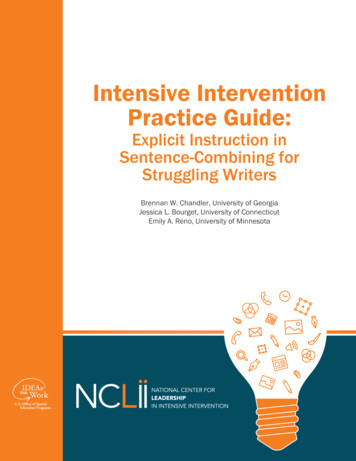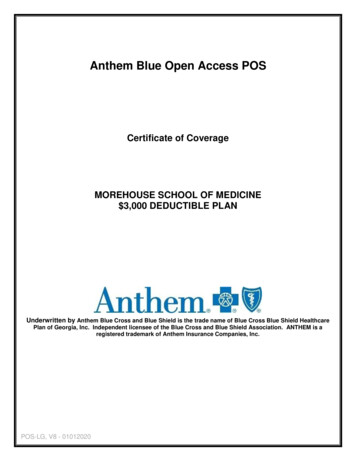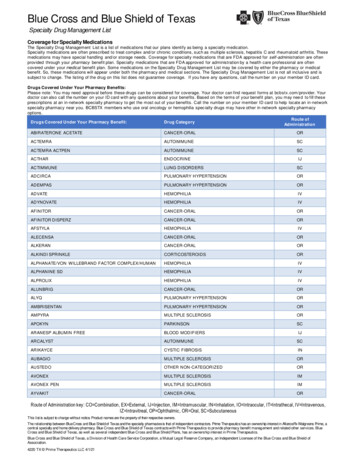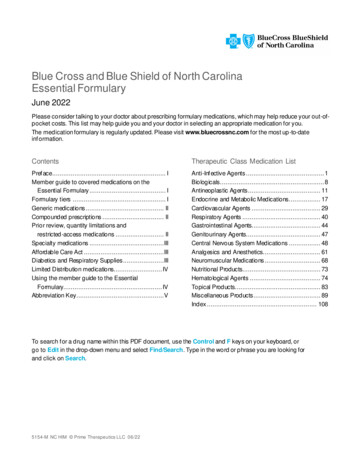
Transcription
264thCOMMENCEMENTRED AND BLUE,B R AV E A N D N E W :T H E F I R S T C E L E B R AT I O N O FTHE CLASS OF 2020May 18, 2020 11:00 a.m. et
Class of 2020 Celebration ProgramMUSICAL PERFORMANCEGREETINGSUniversity of Pennsylvania Marching BandDirector:R. Greer Cheeseman IIIAssistant Directors:Kushol GuptaAdam SherrProgram Assistant:Robin CoyneVideo Production:Jackson Betz, C’19Steven Birmingham, C’91Brian Greenberg, W’91Performers:James Morrison, C’22Zachary Abraham, C’20Leah Narun, ENG’22Justin Amgott, C’22Laila Norford, ENG’23Katelyn Boese, C’23Rachel Orth, C’20Fernando Bonilla, C’20Amanda Palamar, C’23Isabel Buckingham, NU’22Caitlyn Pelletier, C’23McKay Burdette, C’20Trevor Pennypacker, ENG’20Landon Butler, ENG’22Lexi Raday, C’22Charlotte Cecarelli, NU’22Madeline Rice, ENG’20Helen Chung, C’22Noah Ryan, C’22David Fernandez, C’21Hannah Salazar, C’20Caitlin Frazee, ENG’22Angela Schmitt, C’22Connor Gallagher, ENG’20Nicolas Tapiero, ENG’21Josh Gardos, C’22Noah Tatman, ENG’21Miriam Glickman, ENG’21Davis Tran, ENG’23Jesse Goodale, C’20Chad Vigil, C’20Sofia De Guzman, C’20Saloni Wadhwa, W’20Ryan Jurewicz, ENG’21Bernie Wang, C’21, W’21Lisa Kalnik, NU’22Erica Winston, ENG’23Dominique Martinez, C’20Alex Worrall, C’23Megan McKelvey, C’20Criston Young, C’23Aaron Mittleman, C’20Amy Gutmann, PresidentCLASS OF 2020 TRIBUTEFeaturing:Nia Akins, NU’20Liza Babin, C’20AJ Brodeur, W’20Gregory Callaghan, GR’20Angelica Du, ENG’20Karim El Sewedy, W’20, ENG’20Ezzaty Binti Hasbullah, C’20Cinthia Ibarra, C’20David Kirui, GED’11, GRW’18, GR’20Louis Lin, C’20Natasha Menon, C’20Arman Ramezani, C’20, W’20HONORARY DEGREE RECIPIENTSChimamanda Ngozi AdichieDoctor of Humane Letters andClass of 2020 Commencement SpeakerAuthor, educator, and international speakerMacArthur Foundation FellowAnthony M. KennedyDoctor of LawsAssociate Justice, RetiredSupreme Court of the United StatesJhumpa LahiriDoctor of Humane LettersAuthor and translatorProfessor of Creative Writing and Director, Creative WritingProgram, Princeton UniversityRecipient, Pulitzer Prize for FictionTHE NATIONAL ANTHEMDuval Courteau, C‘20INVOCATIONJill LeporeDoctor of Humane LettersAmerican historian and authorDavid Woods Kemper ’41 Professor of American History,Harvard UniversityStaff writer, The New YorkerCharles L. Howard, ChaplainStanley A. PlotkinDoctor of SciencesPhysician, educator, researcher, and developer of vaccinesEmeritus Professor of Pediatrics, Perelman School ofMedicine, University of PennsylvaniaProfessor Emeritus of Virology, Wistar Institute, PhiladelphiaSister Mary ScullionDoctor of Humane LettersAdvocate in service of the homeless and mentally illCo-founder, Project HOME, PhiladelphiaMember of the Sisters of Mercycontinued next page2
Class of 2020 Celebration Program, continuedGregg L. Semenza, M’82, GR’84Doctor of SciencesC. Michael Armstrong Professor of Genetic Medicine,Johns Hopkins UniversityFounding Director, Vascular Biology Program,Johns Hopkins Institute for Cell EngineeringRecipient of the 2019 Nobel Prize in Physiology or MedicineTheodore Ruger, Dean, Penn Law SchoolJuris Doctor, Master of Laws, Master in Law,Doctor of the Science of LawFrederick Steiner, Dean, Stuart Weitzman School of DesignMaster of Architecture, Master of City Planning, Master ofFine Arts, Master of Landscape Architecture, Master of UrbanSpatial Analytics, Master of Science in Design, Master ofScience in Historic PreservationHenry ThreadgillDoctor of MusicJazz composer and multi-instrumentalist artistRecipient, Pulitzer Prize for MusicMark Wolff, Morton Amsterdam Dean of Dental MedicineDoctor of Dental Medicine, Doctor of Science in Dentistry,Master of Science in Oral BiologyACADEMIC HONORSWendell E. Pritchett, ProvostAndrew Hoffman, Gilbert S. Kahn Dean ofVeterinary MedicineDoctor of Veterinary MedicineCONFERRAL OF DEGREESSteven J. Fluharty, Dean, School of Arts and SciencesBachelor of Arts, Bachelor of Fine Arts, Bachelor of AppliedArts and Sciences, Master of Applied Positive Psychology,Master of Behavioral and Decision Science, Master ofChemical Sciences, Master of Environmental Studies,Master of Liberal Arts, Master of Philosophy, Master ofPublic Administration, Master of Science in OrganizationalDynamics, and Master of Science in Applied GeosciencesPam Grossman, Dean, Graduate School of EducationMaster of Science in Education, Master of Philosophy inEducation, Doctor of EducationSara S. Bachman, Dean, School of Social Policy and PracticeMaster of Social Work, Master of Science inNonprofit/NGO Leadership, Master of Science in SocialPolicy, Doctor of Social WorkVijay Kumar, Nemirovsky Family Dean,School of Engineering and Applied ScienceBachelor of Applied Science, Bachelor of Science inEngineering, Master of Science in Engineering, Masterof Biotechnology, Master of Computer and InformationTechnology, Master of Integrated Product DesignJohn L. Jackson, Jr., Walter H. Annenberg Dean,Annenberg School for CommunicationPhD only program at the graduate level.Beth Winkelstein, Vice Provost for EducationMaster of Arts, Master of Science, Doctor of PhilosophyGeoffrey Garrett, Dean, The Wharton SchoolBachelor of Science in Economics, Master of BusinessAdministrationCLOSING REMARKSAmy Gutmann, PresidentMUSICAL PERFORMANCEAntonia Villarruel, Margaret Bond Simon Dean of NursingBachelor of Science in Nursing, Master of Science in Nursing,Doctor of Nursing PracticeThe Red and the BluePerformers:Rachel Baum, C’20Juan Botero, C’20Duval Adel Courteau, C’20Catherine de Luna, C’20Angelica Du, ENG’20Priscilla Felten, W’20Luiza Repsold França, C’20Hana Flaxman, C’20Shane Goldstein, W’20Kimberly Halberstadter, C’20Henry Hoffman, C’20Edward Kim, C’20John Legend, C’99Jason Li, ENG’20J. Larry Jameson, Executive Vice President,University of Pennsylvania for the Health System,and Dean of the Perelman School of MedicineDoctor of Medicine, Master of Bioethics, Master ofHealth Care Innovation, Master of Public Health,Master of Regulatory Affairs, Master of Science in ClinicalEpidemiology, Master of Science in Medical Ethics,Master of Science in Translational Research,Master of Science in Health Policy Research3Kyler Li, C’20Natalia Lindsey, C’20Carolynne Liu, C’20Michael Montague, C’20Michelle Nigro, NU’20Deborah Oh, C’20, ENG’20Eduardo Ortuño Marroquin,ENG’20Kwaku Owusu, W’20Abigail Presti, C’20Caroline Terens, C’20Evan Thomas, W’20Siani Woods, W’20Tiger Zhang, W’20
Schools of the UniversitySCHOOL OF ARTS AND SCIENCES (1755)LAW SCHOOL (1790)The School of Arts and Sciences (SAS) is the direct descendantof the College of Philadelphia, where Benjamin Franklinestablished the first modern arts and sciences curriculum inthe English colonies. Undergraduate programs for men dateto the chartering of the College in 1755; the College of LiberalArts for Women was founded in 1933. The Graduate Schoolwas established in 1882 with the appointment of a Faculty ofPhilosophy. The College of Liberal and Professional Studies(lifelong learning) traces its roots to 1892. The School of Artsand Sciences was born in 1974 with the merger of the Collegeof Arts and Sciences, the College for Women, the GraduateSchool, and four social science departments from Wharton.Today SAS is the largest of the University’s 12 schools,providing a liberal arts education for all Penn undergraduatesand supporting graduate studies, basic research, andcontinuing education across the full range of the humanities,natural sciences, and social sciences. The School has 27departments with 514 standing faculty, 25 research centers,four interschool institutes, and 10,000 students.Penn’s engagement in legal education began in 1790 witha series of lectures to President Washington and his cabinetby James Wilson, the University’s first law professor, a signerof the Declaration of Independence and one of the originaljustices of the Supreme Court of the United States. A formalprogram of instruction in law was established in 1850 underGeorge Sharswood, and innovative legal education has beenpart of the Penn fabric since that time. In November 2019,the W. P. Carey Foundation made a historic gift, the largestever to a law school. In recognition of this generosity, theschool was named the University of Pennsylvania Carey LawSchool. The Law School provides a cross-disciplinary, globallyfocused legal education taught by preeminent scholars,approximately 70 percent of whom hold advanced degreesin fields in addition to law. Students augment the teachingprovided by Law faculty with classes taken – and certificatesof study and joint degrees earned – in sister schools anddepartments throughout the University. In the 2019-2020academic year, the Law School has over 950 students and 86full-time faculty. The Law School awards five degrees: JurisDoctor; Master of Laws for internationally trained lawyers;Master of Comparative Laws; Doctor of Juridical Science;and Master in Law for non-lawyers.PERELMAN SCHOOL OF MEDICINE (1765)Established in 1765 as the nation’s first medical school, whatis now known as the Raymond and Ruth Perelman School ofMedicine at the University of Pennsylvania continues a richtradition of providing the nation’s best medical training andeducation, with service to its community as a cornerstone.Today, the school, which has been named to the top fiveresearch-oriented medical schools in the nation by U.S. Newsand World Report, honors its long standing commitmentto advancing knowledge and improving health close tohome and across the world through research, patient care,and the education of trainees in an inclusive culture thatembraces diversity. More than 770 students are pursuingmedical degrees in the Perelman School, and more than 700are studying toward doctorates in biomedical sciences, withover 200 more enrolled in joint MD/ PhD programs. Acrossthe school’s affiliated hospitals, 1,400 residents and fellowsare completing their medical training. Over the past decade,the Perelman School of Medicine has consistently beenranked among the top recipients of research funding from theNational Institutes of Health.SCHOOL OF ENGINEERING AND APPLIEDSCIENCE (1852)The School of Engineering and Applied Science is oneof the oldest in the United States, tracing its beginningsto the establishment of the School of Mines, Arts andManufactures in 1852. The first graduate of the Schoolreceived a Bachelor of Science degree in 1854. For the past150 years, engineering has been a vibrant and collaborativecommunity of innovation at Penn. Our world-acclaimedfaculty, state-of-the-art research laboratories and highlyinterdisciplinary curricula offer an experience for ourstudents that is unparalleled. From the time ENIAC, theworld’s first computer, was developed and introduced oncampus in 1946, Penn Engineering has continued a traditionof leadership and cutting-edge research. Innovation andtechnology drive our every program and Penn Engineersplay a critical role in posing and answering the questionsthat will improve lives and transform our world. The PennEngineering community consists of 131 standing faculty,approximately 2,000 undergraduate students, 2,100 graduatestudents and 13 research centers and institutes.STUART WEITZMAN SCHOOL OF DESIGN (1869)Although the School of Design dates its founding from1890, architecture courses were first offered at the Universityof Pennsylvania in 1869, making Penn’s architectureprogram the second oldest in the United States. In1921, the Department of Architecture joined with theDepartment of Music and Fine Arts to create an independentundergraduate School of Fine Arts modeled on the French4
Schools of the University, continuedacademic year, Penn Dental Medicine has 613 DMD students,122 Post-Doctoral Students, 12 of which are enrolled in theDoctor of Science in Dentistry with Certificate and 30 ofwhich are in the Master of Science in Oral Biology Programwith certificate, 5 are in the Doctor of Science in Dentistrystand-alone program and 17 postdoctoral researchers. PennDental Medicine has 425 faculty members, including 50standing faculty.WHARTON SCHOOL (1881)Founded in 1881 as the world’s first collegiate businessschool, the Wharton School of the University ofPennsylvania is shaping the future of business by incubatingideas, driving insights, and creating leaders who change theworld. With a faculty of more than 235 renowned professors,Wharton has 5,000 undergraduate, MBA, executive MBAand doctoral students. Each year 18,000 professionals fromaround the world advance their careers through WhartonExecutive Education’s individual, company-customized, andonline programs. More than 99,000 Wharton alumni form apowerful global network of leaders who transform businessevery day.École des Beaux Arts. In 1958, the School was renamed theGraduate School of Fine Arts, reflecting the shift to graduatedegree offerings in architecture, city and regional planning,landscape architecture, and fine arts. In the 1980s, a programin historic preservation was added. To more accuratelycapture the School’s sphere of influence, it was renamed theSchool of Design in 2003. In recognition of both his lifetimephilanthropic support of Penn and his active engagementwith its academic activities, the School was named foraward-winning designer and footwear icon Stuart Weitzman,Wharton Class of 1963, in February of 2019. Today, witha standing faculty of 43, approximately 170 lecturers andassociated faculty, and more than 700 students, the Schoolprepares students to address complex sociocultural andenvironmental issues through thoughtful.SCHOOL OF VETERINARY MEDICINE (1884)Ranked among the top 10 veterinary schools worldwide, theUniversity of Pennsylvania School of Veterinary Medicine(Penn Vet) is a global leader in veterinary education,research, and clinical care. Founded in 1884, Penn Vet isthe first veterinary school developed in association with amedical school. The School is a proud member of the OneHealth initiative, linking human, animal, and environmentalhealth. Penn Vet serves a diverse population of animals atits two campuses, which include extensive diagnostic andresearch laboratories. Ryan Hospital in Philadelphia providescare for dogs, cats, and other domestic/companion animals,handling nearly 35,300 patient visits a year. New BoltonCenter, Penn Vet’s large-animal hospital on nearly 700 acresin rural Kennett Square, PA, cares for horses and livestock/farm animals. The hospital handles nearly 5,300 patientvisits a year, while the Field Service treats more than 38,000patients at local farms. In addition, New Bolton Center’scampus includes a swine center, working dairy, and poultryunit that provide valuable research for the agricultureindustry.SCHOOL OF DENTAL MEDICINE (1878)Established in 1878 as the Dental Department of theUniversity of Pennsylvania, the School of Dental Medicine isamong the oldest university-affiliated dental institutions inthe country with a history deeply rooted in forging precedentsin dental education, research, and patient care. In 1897,Thomas W. Evans, a Philadelphia native and clinician whospent most of his life in France as the dentist to Europeannobility, left his estate to create a dental school that was“second to none.” Evans’ bequest would become one with theUniversity, creating the Thomas W. Evans Museum and DentalInstitute, which opened in 1915. Today, the Evans Buildingremains the site of much of the School’s clinical instruction.The dental campus also includes the Robert SchattnerCenter and the Leon Levy Center for Oral Health Research,home to the basic sciences and extensive research activities.Penn Dental Medicine is a major provider of care in WestPhiladelphia and through outreach programs, students lognearly 13,100 hours each year serving approximately 15,200residents in the surrounding Philadelphia neighborhoods.Penn Dental Medicine offers the degrees of Doctor of DentalMedicine, Master of Science in Oral Biology, Doctor of Sciencein Dentistry and trains postdoctoral students in endodontics,oral medicine, oral and maxillofacial surgery, orthodontics,pediatric dentistry, periodontics, periodontics/orthodontics,periodontal/prosthesis and prosthodontics. In the 2019-2020GRADUATE SCHOOL OF EDUCATION (1914)The University of Pennsylvania Graduate School ofEducation (Penn GSE) is one of the nation’s premier schoolsof education, consistently producing top-ranked researchersand educational leaders. The University of Pennsylvaniacreated its first professorship in education in 1894 andestablished the full-fledged School of Education in 1914.The School’s first graduating class in 1915 comprised threewomen and three men, who received the School’s firstBachelor of Science in Education degrees. In 1961, the5
Schools of the University, continuedSchool was restructured and renamed the Graduate School ofEducation. Penn GSE launched an Administrative LeadershipProgram in 1971 to prepare school administrators for creativeand dynamic leadership. This was the first in a long lineof successful leadership programs. Today, Penn GSE offersthirty-seven programs leading to the PhD, EdD, MPhil Ed,and MS Ed degrees in more than thirty fields of education.Reflecting a deep commitment to urban education, PennGSE’s students and researchers are involved in schools acrossevery catchment area of the School District of Philadelphia,including robust partnerships with two West Philadelphiaschools. Penn GSE is also home to the Milken-Penn GSEEducation Business Plan Competition, intended to sparkinnovations that improve education by bringing togetherentrepreneurs and funders for sustained collaboration. Noother education school enjoys a university environment assupportive of practical knowledge building as Penn GSE.work and social change, the School educates clinicians,policymakers, scholars, researchers, and leaders who workto advance the human welfare of local, national, and globalcommunities. The School houses a number of researchcenters and programs, including: Center for High ImpactPhilanthropy; Center for Mental Health and Aging; Centerfor Social Impact Strategy; Field Center for Children’s PolicyPractice and Research; Ortner Center on Violence & Abuse;Actionable Intelligence for Social Policy (AISP); AnnualHomelessness Assessment Report; Critical Policy Studies;Health Ecologies Lab; Penn Restorative EntrepreneurshipProgram; Program for Religion and Social Policy Research;SexGen Policy Lab; Social Impact of the Arts Project; SocialJustice and Arts Integration Initiative; Goldring ReentryInitiative; Ann Nolan Reese Penn Aging Certificate; ChildWell-Being & Child Welfare Specialization; Criminal JusticeSpecialization; LGBTQ Certificate; Social Work in HealthCare Specialization; Cohen Veterans Network MSW ScholarsProgram; and Data Analytics for Social Policy Certificate. TheSchool has 26 standing faculty, two full-time lecturers, and527 students.SCHOOL OF NURSING (1935)Nursing Education at Penn began in 1886 when theHospital of the University of Pennsylvania started a nursetraining program. In 1935, the Trustees of the University ofPennsylvania established a nursing degree program within theSchool of Education, and in 1950 the School of Nursing wasestablished. The Master of Science in Nursing program wasinstituted in 1961, the Doctor of Nursing Science programin 1978, the Doctor of Philosophy program in 1984, andthe Doctor of Nursing Practice program in 2016. Theseinnovations and a curriculum which progressively reflectschanging health care delivery patterns have advanced theSchool into the first rank of American schools of nursing. TheSchool has two departments, Biobehavioral Health Sciencesand Family and Community Health. It is widely recognizedfor its leadership in nursing research in the areas of healthoutcomes and policy research, nursing history, biobehavioralhealth sciences, global women’s health, health equity, aging,and transitions in health. It also has a global reputation forinnovations in nurse-managed clinical practice and is a WorldHealth Organization Collaborating Center for Nursing andMidwifery Leadership. The School of Nursing has 57 standingfaculty and 1,317 students.ANNENBERG SCHOOL FOR COMMUNICATION(1959)Founded through the generosity and vision of diplomatand philanthropist Walter Annenberg, the AnnenbergSchool for Communication (ASC) at the University ofPennsylvania is devoted to furthering our understandingof the role of communication in public life throughresearch, education, and service. At the School’s founding,Ambassador Annenberg identified its unique mission:“Every human advancement or reversal can be understoodthrough communication. The right to free communicationcarries with it responsibility to respect the dignity of others— and this must be recognized as irreversible. Educatingstudents to effectively communicate this message and tobe of service to all people is the enduring mission of thisschool.” With strengths in health communication, politicalcommunication, culture and communication, mediainstitutions, digital media, visual communication, and globalcommunication, ASC is one of the top communicationschools in the nation. The Annenberg School has 21standing faculty members, 30 additional research andteaching faculty and associates, 70 graduate students, andnearly 200 undergraduate Communication majors. TheSchool offers the degree of Doctor of Philosophy as well asa Bachelor of Arts major run through the College of Artsand Sciences. The School is home to the Annenberg PublicPolicy Center; Center for Media at Risk; Center for AdvancedResearch in Global Communication; CommunicationNeuroscience Lab; Network Dynamics Group; Institute forthe Study of Citizens and Politics; Media, Inequality andChange Center; and Institute for Public Service, amongmany other projects pursuing innovative communicationresearch and teaching.SCHOOL OF SOCIAL POLICY & PRACTICE (1948)The School of Social Policy & Practice began in 1908 as aprivate school that opened its doors to five students in thefield of child welfare. The School affiliated itself with theUniversity in 1935 and became a formal school in 1948. In2005, it changed its name from the School of Social Workto the School of Social Policy & Practice. The School offersthe Master of Social Work, Master of Science in NonprofitLeadership, Master of Science in Social Policy, Doctor ofPhilosophy in Social Welfare, and Doctor of Social Workdegrees. The School is devoted to advancing humanwelfare, promoting social justice, and developing effectivesocietal responses to global human need. Building on theSchool’s more than century-long commitment to social6
Honorary Degree RecipientsCHIMAMANDA NGOZIADICHIEANTHONY M. KENNEDYHonorary Doctor of LawsAssociate Justice, RetiredSupreme Court of the United StatesHonorary Doctor of HumaneLetters and Class of 2020Commencement SpeakerAuthor, educator, andinternational speakerMacArthur Foundation FellowAssociate Justice of the United StatesSupreme Court Anthony M. Kennedyserved for thirty years, from hisnomination by President RonaldReagan and unanimous confirmation by the U.S. Senate in1988 until his retirement in 2018. Justice Kennedy authoredmany opinions for the Court on some of the most significantlegal issues of our time, including the Court’s decisionstriking down the death penalty for juvenile offendersand 2015’s Obergefell v. Hodges that cleared the way for samesex marriage nationwide. Throughout his years onthe bench, he established himself as a strong proponentof individual rights.Chimamanda Ngozi Adichie is the widely-acclaimed authorof several award-winning novels and one collection of shortstories. A native of Anambra, Nigeria, she grew up on thecampus of the University of Nigeria, Nsukka, where herfather taught and her mother was the first female registrar.She studied medicine for a year at Nsukka, and then left forthe United States at 19 to follow a different path. Earninga scholarship to study at Drexel University in Philadelphia,Ms. Adichie went on to complete her undergraduate studiesat Eastern Connecticut State University. She then earned aMaster’s in Creative Writing from Johns Hopkins Universityand a Master of Arts in African History from Yale University.The recipient of fellowships at Princeton University and theRadcliffe Institute of Harvard University, Ms. Adichie receiveda MacArthur Foundation Fellowship in 2008.A native of Sacramento, California, Justice Kennedy waseducated at Stanford University and the London School ofEconomics, receiving his Bachelor of Laws from HarvardLaw School. Following law practices in San Francisco andSacramento, Justice Kennedy was appointed to the U.S.Court of Appeals for the Ninth Circuit by President GeraldFord in 1975, at that time making him the youngest federalappellate judge in the United States, and the third youngestin history to be thus appointed.She began her first novel, Purple Hibiscus, during her senioryear in college. The work won the Commonwealth Writers’Prize. Her second novel, Half of a Yellow Sun, won the OrangePrize. In 2013, Americanah won the U.S. National Book CriticsCircle Award and was named one of the New York TimesTop Ten Best Books.In California, during his practice and years on the bench,he taught Constitutional Law at the University of the PacificMcGeorge School of Law, and for years was the school’slongest-serving active faculty member. Justice Kennedy haslectured at law schools and universities worldwide, teachingin China and offering a course at the University of Salzburgentitled “Fundamental Rights in Europe and the UnitedStates.” He represented the United States on the UnitedNations Commission on the Legal Empowerment ofthe Poor.Ms. Adichie is recognized for landmark TED talks, including2009’s The Danger of A Single Story. Her 2012 talk, We ShouldAll Be Feminists, fostered a worldwide conversation aboutfeminism, and was published as a book in 2014. Ms. Adichie’smost recent work, Dear Ijeawele, or a Feminist Manifesto inFifteen Suggestions, was published in 2017. Her work, oftentaking on themes of politics, religion, and love, has beentranslated into over thirty languages.Justice Kennedy has received a great many awards from BarAssociations, Law Schools, and other entities in recognitionof his service to the law and to the judiciary. In his honor,endowed chairs have been established in his name atthe Law School of the University of Virginia and at theUniversity of the Pacific McGeorge School of Law.In 2017, Ms. Adichie received the “Le Grand Prix de l’héroïneMadame Figaro” and the PEN Pinter Prize in 2018. Fortunenamed her one of the World’s 50 Greatest Leaders in 2017.She is a member of the American Academy of Arts and Lettersand the American Academy of Arts and Sciences. Ms. Adichiedivides her time between the United States and Nigeria, whereshe leads an annual creative writing workshop.7
Honorary Degree Recipients, continuedJHUMPA LAHIRIJILL LEPOREHonorary Doctor ofHumane LettersAuthor and translatorProfessor of Creative Writing andDirector, Creative Writing Program,Princeton UniversityRecipient, Pulitzer Prize for FictionHonorary Doctor ofHumane LettersAmerican historian and authorDavid Woods Kemper ’41 Professor ofAmerican History, Harvard UniversityStaff writer, The New YorkerAmerican historian and author JillLepore is the David Woods Kemper ’41 Professor of AmericanHistory at Harvard University. The author of over a dozenbooks as well as an acclaimed staff writer at The New Yorker,Dr. Lepore’s work explores themes of American history, law,literature, and politics. Dr. Lepore’s essays and reviews havealso appeared widely, including in the New York Times, theTimes Literary Supplement, the Journal of American History,and the American Quarterly.London-born author and translator Jhumpa Lahiri moved tothe United States as a young child with her Bengali parents.Dr. Lahiri has observed that she grew up with “conflictingexpectations to be Indian by Indians and American byAmericans.” Her insightful debut story collection, Interpreterof Maladies, explores issues of identity among immigrants andcultural transplants and was recognized with the Pulitzer Prizefor Fiction in 2000.A graduate of Barnard College, Dr. Lahiri also earned severaldegrees, including her Ph.D., from Boston University. Since2015, she has been at the Lewis Center for the Arts’ Programin Creative Writing at Princeton University as a Professorof Creative Writing, and was named director of theprogram in 2019.Her most recent book is 2019’s This America: The Case for theNation. Her 2018 work, These Truths: A History of the UnitedStates, has been translated and published around the world.Her national bestseller The Secret History of Wonder Womanreceived the 2015 American History Book Prize.Dr. Lepore completed her undergraduate work at TuftsUniversity, received her M.A. in American Culture from theUniversity of Michigan, and a Ph.D. in American Studiesfrom Yale University. Following teaching at the Universityof California-San Diego and Boston University, she joinedHarvard’s History Department in 2003 and was several yearsChair of the History and Literature Program. In 2012, shewas named a Harvard College Professor. Dr. Lepore teachesclasses in evidence, historical methods, the humanities, andAmerican political history.The author of three novels and numerous short fictionand nonfiction works, Dr. Lahiri’s short story collection,Unaccustomed Earth, received the 2008 Frank O’ConnorInternational Short Story Award and debuted at the top ofthe New York Times best seller list. The Lowland won theDSC award for South Asian Literature, and was a finalistfor the Man Booker Prize and the National Book Award infiction. 2016’s autobiographical In Other Words, written inItalian, considers the often-fraught links between identityand language. Dr. Lahiri has also published the ItalianThe Clothing of Books and the novel Dove Mi Trovo, with itsEnglish translation as Whereabouts in production. In 2019,she compiled and translated the work of 40
Class of 2020 Celebration Program. MUSICAL PERFORMANCE. University of Pennsylvania Marching Band. Director: R. Greer Cheeseman III. Assistant Directors: Kushol Gupta Featuring:Adam Sherr . Program Assistant: Nia Akins, NU'20Robin Coyne. Video Production: Liza Babin, C'20Jackson Betz, C'19 Steven Birmingham, C'91 Brian Greenberg, W'91 .











